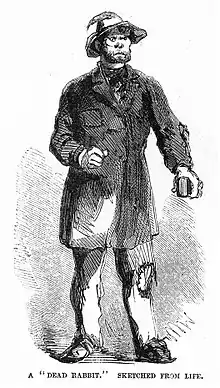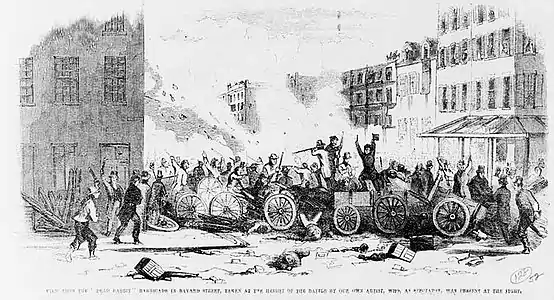Dead Rabbits
The Dead Rabbits was the name of an Irish American criminal street gang active in Lower Manhattan in the 1830s to 1850s. The Dead Rabbits were so named after a dead rabbit was thrown into the center of the room during a gang meeting, prompting some members to treat this as an omen, withdraw, and form an independent gang. Their battle symbol was a dead rabbit on a pike.[1] They often clashed with Nativist political groups who viewed Irish Catholics as a threatening and criminal subculture.[2][3] The Dead Rabbits were given the nicknames of "Mulberry Boys" and the "Mulberry Street Boys" by the New York City Police Department because they were known to have operated along Mulberry Street in the Five Points.[4][5][6]
 Dead Rabbit holding a brickbat as a weapon in July 1857 | |
| Founding location | Five Points, Manhattan, New York (present-day Worth Street, Baxter Street, and Columbus Park), Manhattan, New York City |
|---|---|
| Years active | 1830s-1860s |
| Territory | Five Points, Manhattan |
| Ethnicity | Irish and Irish-American |
| Criminal activities | Street fighting, knife fighting, assault, murder, robbery, arson, rioting |
| Allies | Chichesters, Tammany Hall, Plug Uglies, Roach Guards, Mulberry Street Boys, Municipal Police, Forty Thieves, Shirt Tails, Kerryonians |
| Rivals | Bowery Boys, Atlantic Guards, O'Connell Guards, American Guards, True Blue Americans, Empire Guards, New York City Police Department |
History

The original Dead Rabbits were founded by disgruntled gang members of the Roach Guards, who became the largest Irish crime organization in early 19th-century Manhattan, having well over 100 members when called up for action. Their chief rival gang was the Bowery Boys, native-born New Yorkers who supported the Know Nothing anti-immigrant political party.[1]
These two rival gangs fought more than 200 gang battles in a span of 10 years, beginning in 1834, and they often outmanned the police force and even the state militias. They were also in the forefront of the Dead Rabbits Riot of 1857, and may have participated in the 1863 New York Draft Riots in the American Civil War. Besides street-fighting, the Dead Rabbits supported politicians such as Fernando Wood and the Tammany Hall machine, whose platforms included the welfare and benefit of immigrant groups and minorities, and under the leadership of Isaiah Rynders the gang acted as enforcers to violently persuade voters during elections to vote for their candidates.[3][7] According to legend, one of the most feared Dead Rabbits was "Hell-Cat Maggie", a woman who reportedly filed her teeth to points and wore brass fingernails into battle.[8]
On July 4, 1857, a riot occurred between the Dead Rabbits and the Metropolitan Police, and the Bowery gangs against the Municipal Police, Mulberry Street Boys, Roach Guards, and Dead Rabbits in Bayard Street.[9] The tensions and divisions that were present in Ireland were carried over to New York by the Irish immigrants who were both Protestant and Catholic. Catholic Irish have become synonymous with the term "Irish" however both groups were referred to as Irish until the Partition of Ireland in 1921 in which Ireland was divided into the Republic of Ireland and Northern Ireland, where Protestant Irish then moved to the North and Catholic Irish moved to the South. Ireland has a long and troubled history in which the indigenous population suffered at the hands of an apartheid system known as Protestant Ascendancy for hundreds of years beginning with English colonization of Ireland and ending with Catholic Emancipation in the 1820s. During Protestant Ascendancy the native Catholic population were severely oppressed and denied their rights and liberties. Herbert Asbury states in his book Gangs of New York: An Informal History of the Underworld that the Bowery Boys were an Irish gang, despite being anti-Catholic.[10] Communal violence between both Irish Protestants and Irish Catholics has occurred in July each year since the 1690s in what is known as "Marching Season" which culminates on the 12th of July which is known as The Twelfth.[11][12][13][14][15][16] This is due to an established tradition of a Protestant supremacist[17][18][19] group in Ireland known as the Orange Order who celebrate and assert Protestant dominance over the indigenous Catholic Irish population on the anniversary of the Battle of the Boyne 1690, through harassment, marches and violence. The founder of the Bowery Boys was a Protestant Irishman and later US congressman named Mike Walsh who would have been well versed in The Twelfth.[20] Other "Irish" riots which occurred around the 12th of July in New York City were the 1870 & 1871 Orange Riots and the 1863 New York City Draft Riots, both of which were the worst riots in the city's history. Communal sectarian violence in Ireland has persisted until the present day with a large scale armed conflict occurring from 1969-1998 in a period known as The Troubles which was sparked by the Protestant reaction to a Catholic civil rights march in Northern Ireland known as the 1969 Northern Ireland Riots in which the police beat and shot Catholic civilians in the streets while Protestants mobs burned down Catholic neighborhoods. Communal violence on and around the 12th of July is still a frequent event in Northern Ireland with significant city-wide violence seen during the 2013 Belfast Riots for example.
There was a similar gang in Liverpool, England, in the late 19th century, which mobilized as a militia in times of crisis.[21]
By 1866, mentions of the Dead Rabbits as an organization currently in existence disappeared from New York City newspapers, and they were sometimes referred to in the past tense.[22] The term "Dead Rabbit" was used as late as the 1880s as a generic term for a young, lower class criminal.
Song

Lyrics detailing the Dead Rabbits' battle with the Bowery Boys on July 4, 1857, were written by Henry Sherman Backus[23] and Daniel Decatur Emmett:
Chorus
Then pull off the coat and roll up the sleeve,
For Bayard is a hard street to travel;
So pull and off the coat and roll up the sleeve,
The Bloody Sixth is a hard ward to travel I believe.
Like wild dogs they did fight, this Fourth of July night,
Of course they laid their plans accordin';
Some were wounded and some killed, and lots of blood spill'd,
In the fight on the other side of Jordan.
Chorus
The new Police did join the Bowery boys in line,
With orders strict and right accordin;
Bullets, clubs and bricks did fly, and many groan and die,
Hard road to travel over Jordan.
Chorus
When the new police did interfere, this made the Rabbits sneer,
And very much enraged them accordin';
With bricks they did go in, determined for to win,
And drive them on the other side of Jordan.
Chorus
Upon the following day they had another fray,
The Black Birds and Dead Rabbits accordin;
The soldiers were call'd out, to quell the mighty riot,
And drove them on the other side of Jordan.
In popular culture
In films and television
The Dead Rabbit Riot was featured in the History Channel documentary television series History's Mysteries in 1998. The story of the New York Dead Rabbits is told, in highly fictionalized form, in Martin Scorsese's 2002 film Gangs of New York, which was partially inspired by Herbert Asbury's book Gangs of New York. In the 2014 film, Winter's Tale, the Dead Rabbits and the Short Tails are featured prominently; a similar theme pervades Mark Helprin 1983 novel of the same name. The fourth season of the 2014 television series, Hell on Wheels has a few Dead Rabbit characters.
In literature
A book of poetry by Richard Griffin, The Dead Rabbit Riot, A.D. 1857: And Other Poems, was published in 1915. Patricia Beatty's 1987 historical children's fiction novel Charlie Skedaddle mentions Dead Rabbits (the main character is a Bowery Boy).
Some of the exploits of the Dead Rabbits are dramatized in Chapter XVIII of MacKinlay Kantor's Pulitzer Prize-winning novel Andersonville (1955).
In art
Artist George Henry Hall's 1858 painting is titled A Dead Rabbit (also entitled Study of the Nude or Study of an Irishman), which depicts a dead Dead Rabbit gang member killed during the riot on July 4, 1857, in New York City's Lower East Side.
References
- Buddy, James. Gangs in America's Communities. SAGE Publications, Inc; Buddy edition (November 9, 2011). pg. 5; ISBN 978-1412979535
- Maffi, Mario.Gateway to the Promised Land: Ethnicity and Culture in New York's Lower East Side (Revealing Antiquity; 8), NYU Press; 1st edition (April 1, 1995). pg. 129. ISBN 978-0814755082
- O'Kane, James. The Crooked Ladder: Gangsters, Ethnicity, and the American Dream. Transaction Publishers; New edition (January 31, 2002), pp. 55-57; ISBN 978-0765809940
- Smith, Carter F. (2017). Gangs and the Military: Gangsters, Bikers, and Terrorists with Military Training. Lanham, MD: Rowman & Littlefield. p. 11. ISBN 9781442275171.
- The Encyclopedia of New York City: Second Edition. New Haven, CT: Yale University Press. 2010. ISBN 978-0300182576.
- Caldwell, Mark. (2005). New York Night: The Mystique and Its History. New York, NY: Simon and Schuster. p. 146. ISBN 9780743274784.
- Debra Kelly (19 February 2015). "10 Deadly Street Gangs Of The Victorian Era". Listverse. Retrieved 2023-01-21.
- "7 Infamous Gangs of New York - History Lists". history.com. Retrieved 2017-09-06.
- "Rioting And Bloodshed; The Fight At Cow Bay. Metropolitans Driven from the 6th Ward. Chimneys Hurled Down Upon the Populace. 'Dead Rabbits' Against the 'Bowery hi.'", New York Daily, July 6, 1857.
- Asbury, Herbert (2001). The gangs of New York : an informal history of the underworld. Jorge Luis Borges. New York. ISBN 1-56025-275-8. OCLC 47644025.
{{cite book}}: CS1 maint: location missing publisher (link) - Hepburn, A. C. (1996). A past apart : studies in the history of Catholic Belfast, 1850-1950. Belfast: Ulster Historical Foundation. ISBN 0-901905-75-5. OCLC 35574811.
- "The Inglorious Twelfth". Cleator Moor (Little Ireland) - History | Photos. Retrieved 2023-04-07.
- Levis, R. Barry (2002). "Rituals and Riots: Sectarian Violence & Political Culture in Ulster, 1784–1886. By Sean Farrell. Lexington: The University Press of Kentucky, 2000. xi + 264 pp. $34.95 cloth". Church History. 71 (3): 666–667. doi:10.1017/S0009640700130537. ISSN 0009-6407. S2CID 162591185 – via JSTOR.
- Gray, Tony (1972). The Orange Order. London: Bodley Head. ISBN 0-370-10371-8. OCLC 622800.
- "CAIN: Background: Chronology of Key Events 1800 to 1967". cain.ulster.ac.uk. Retrieved 2023-04-07.
- "Two Hundred Years in The Citadel | PDF | Government | Violence". Scribd. Retrieved 2023-04-07.
- Roe, Paul (2014). Ethnic violence and the societal security dilemma. London. ISBN 978-1-138-81163-8. OCLC 884744137.
{{cite book}}: CS1 maint: location missing publisher (link) - Connolly, Sean (2008). Divided kingdom : Ireland, 1630-1800. Oxford: Oxford University Press. ISBN 978-0-19-156243-3. OCLC 263375417.
- "Kinder, gentler or same old Orange?". IrishCentral.com. 2009-07-16. Retrieved 2023-04-07.
- Adams, Peter (2005). The Bowery Boys : street corner radicals and the politics of rebellion. Westport, Conn.: Praeger Publishers. ISBN 0-275-98538-5. OCLC 57193072.
- Macilwee, Michael. The Gangs of Liverpool: From the Cornermen to the High Rip The Mobs That Terrorised a City. Milo Books, 2006; ISBN 1-903854-54-7
- "22 Sep 1869, Page 3 - The New York Herald at Newspapers.com". Newspapers.com. Retrieved 2021-05-02.
- "Murder by Gaslight: The Saugerties Bard". murderbygaslight.com. Retrieved 2017-09-06.
Sources
- Asbury, Herbert. The Gangs of New York. New York: Alfred A. Knopf, 1928; ISBN 1-56025-275-8
- Sifakis, Carl. The Encyclopedia of American Crime. New York: Facts on File Inc., 2001; ISBN 0-8160-4040-0